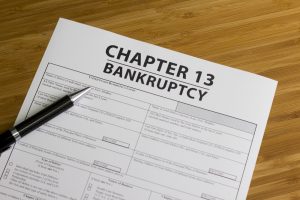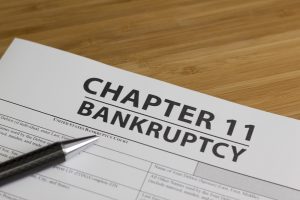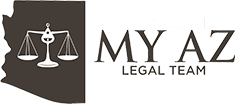Introduction to Bankruptcy for Small Businesses
Filing bankruptcy has options for not just individuals, but for businesses as well. In fact, businesses and individuals can file the same Chapters of bankruptcy a�� Chapter 7 and Chapter 13. While individuals can file Chapter 11 bankruptcy, it is usually utilized by small businesses who do not qualify for Chapter 13 bankruptcy. Depending on the type of business and the amount of money owed, a small business could have a great range of options for bankruptcy.
Sole Proprietorship, Partnership, Corporations and Limited Liability Companies and Bankruptcy
 There are a few different types of business structures, but all are able to file for Chapter 7 bankruptcy in their financial situation is strained enough.[i] The first type of business that can file Chapter 7 bankruptcy is a sole proprietorship. A sole proprietorship is owned by a person who owns an unincorporated business by himself or herself.[ii] A business that is a sole proprietorship is not a separate legal entity, and so it cannot file bankruptcy by itself a�� the owner must file for a personal Chapter 7 bankruptcy.[iii] For this reason, the debts of the business will be treated like the personal debts of the sole proprietor and can be wiped out through discharge.[iv] Exemptions can also be utilized through this process in order to protect some of the businesses assets.[v] For a sole proprietorship that wishes to continue with the business, exemptions can be a crucial key to this. Otherwise, all of the assets of the business will be sold off during the bankruptcy and there would be nothing left over for the business to continue on.
There are a few different types of business structures, but all are able to file for Chapter 7 bankruptcy in their financial situation is strained enough.[i] The first type of business that can file Chapter 7 bankruptcy is a sole proprietorship. A sole proprietorship is owned by a person who owns an unincorporated business by himself or herself.[ii] A business that is a sole proprietorship is not a separate legal entity, and so it cannot file bankruptcy by itself a�� the owner must file for a personal Chapter 7 bankruptcy.[iii] For this reason, the debts of the business will be treated like the personal debts of the sole proprietor and can be wiped out through discharge.[iv] Exemptions can also be utilized through this process in order to protect some of the businesses assets.[v] For a sole proprietorship that wishes to continue with the business, exemptions can be a crucial key to this. Otherwise, all of the assets of the business will be sold off during the bankruptcy and there would be nothing left over for the business to continue on.
The next type of business is the partnership. A partnership is a relationship that exists between two or more persons who join together to carry on a trade or business.[vi] In a partnership, each person contributes money, property, labor, or skill and unless otherwise agreed upon, will share profits and losses of the business.[vii] A partnership is a separate legal entity so it can file for Chapter 7 bankruptcy independently of the partners.[viii] For this reason, the law says that the business does not receive any exemptions to protect its assets and must liquidate everything to pay off its creditors.[ix] There is also no discharge of the debts through the bankruptcy proceeding.[x] Unlike a sole proprietorship, the partnershipa��s bankruptcy does not affect the personal liability of its partners.[xi] If after liquidating all assets of the business there are still debts, creditors can only go after the partners if the partners are personally liable for the debts.[xii]
A corporation is an independent legal entity, which is separate from the people who own, control, and manage the business. A corporation has a very similar process as the partnership – it can file for Chapter 7 bankruptcy independently of any people running the corporation.[xiii] A corporation also is unable to use exemptions nor is it eligible for discharging the debts after the bankruptcy proceeding.[xiv] Again, if a businessman of the corporation was personally liable for the corporations debts, then creditors may go after that businessman but otherwise the people who own, control, and/or manage the corporation will not be on the hook for corporations debts.
The final type of business is a limited liability company (LLC). The LLC combines the best of both worlds from the sole proprietorship and the corporation. The LLC is eligible for similar tax breaks as the sole proprietorship but it limits the liability of the owners just as a corporation does.[xv] The process in which a LLC goes through bankruptcy is very similar to the corporation but the business owner can also go through a personal bankruptcy to wipe out the debts since they are connected to the business just as the sole proprietorship is.[xvi]
Chapter 13 Bankruptcy for Small Businesses

Now, a small business can also file for Chapter 13 bankruptcy and for some businesses, this may be a better option than Chapter 7 bankruptcy. The only downside to Chapter 13 bankruptcy filing for small businesses is that it is really only available for sole proprietorships. The businesses that are considered a separate legal entity, such as the partnerships, corporations and LLCS, are unable to file for Chapter 13 bankruptcy.[xvii] On the other hand, if a business person is personally liable for the debts of the separate legal entity business (corporation or LLC), then that individual can file for Chapter 13 bankruptcy and attempt to have those liabilities discharged through the bankruptcy proceeding.[xviii]
However, a sole proprietorship can file a personal Chapter 13 bankruptcy and wipe out their personal and business debts.[xix] Chapter 13 bankruptcy allows the business to reorganize and pay off all or a portion of your debts through a repayment plan.[xx] The payment plan usually lasts between three and five years and allows for the business to remain operation during the process.[xxi] Another positive aspect of Chapter 13 bankruptcy for small businesses is that during the bankruptcy proceeding the business can remain open because they are not required to sell off all of their assets in order to pay the creditors. This is different from Chapter 7 because unless the item falls into an exemption, the assets have to be sold off in an attempt to pay the creditors.
During the Chapter 13 bankruptcy, the individual filing must include all the debts they are liable for a�� which will include both personal debts separate from the business and personal debts that stem from the business.[xxii] Again, this will occur for sole proprietorships primarily, but it can occur if a businessman is personally liable for any debts connected with the business that is a separate legal entity (partnerships, corporations and LLCs). A major benefit of Chapter 13 bankruptcy is that the business is able to keep nonexempt assets while the business reorganizes and pays off the debts during that three to five year period.[xxiii]
An important note about Chapter 13 bankruptcy is that this bankruptcy proceeding is subject to debt limits.[xxiv] The current law states that an individual cannot file for Chapter 13 bankruptcy if they owe more than $383,175 in unsecured debts or $1,149,525 in secured debts.
Chapter 11 Bankruptcy for Small Businesses
Finally, Chapter 11 bankruptcy has a lot of similarities to Chapter 13 bankruptcy. To begin with, a business can restructure its finances through a reorganization plan, which has been court approved.[xxv] The business can also sell some of its assets in order to downsize the business, if that would be more beneficial for the company. Chapter 11 bankruptcy is a good option for businesses that want to file for Chapter 13 bankruptcy but exceed the debt limit that has been provided for Chapter 13 bankruptcy.

Typically, the rules for Chapter 11 bankruptcy remain the same regardless of the type of business, but there are some options for small businesses in order to get through the process quicker.[xxvi] Under the bankruptcy code, a small business is defined as a person or entity who is engaged in business or other commercial activities and owes no more than $2,490,925 in total claims.[xxvii] There are a few special procedures for small businesses going through Chapter 11 bankruptcy that other businesses are not eligible for. The first one is there is no requirement for a creditora��s committee.[xxviii] Ordinarily, a committee is appointed to represent the interests of the unsecured creditors during the Chapter 11 bankruptcy.[xxix] With a small business proceeding, this is not necessary. Next, a small business must report and file additional documents that other businesses will not have to.[xxx] Also, A small business will be subject to more oversight from the United States Trusteea��s office than other businesses.[xxxi]
Ordinarily a business going through Chapter 11 bankruptcy does not have a deadline for filing their Chapter 11 plan, unless the court has ordered the business to do so.[xxxii] On the other hand, a small business has 300 days to turn in a Chapter 11 plan to the bankruptcy court for their proceeding.[xxxiii] In some Chapter 11 proceedings, a creditor may propose a Chapter 11 plan before the business, or a creditor may propose a plan that competes with the businessa��s plan.[xxxiv] In a typical Chapter 11 bankruptcy proceeding, the business will have exclusive right for 120 days after the filing of the bankruptcy to propose a Chapter 11 plan.[xxxv] A small business will have 180 days to file a Chapter 11 plan, which can help alleviate any need to litigate competing plans between the business and the creditor.[xxxvi] Finally, a small business has no requirement to file a disclosure statement. A disclosure statement provides extensive information about the debtor and the proposed plan.[xxxvii] This document has to be given to creditors and other interested parties, after approval by the court a�� and can be pretty expensive.[xxxviii]A� Luckily for a small business, they do not have to complete this document. A�For more information on bankruptcy for small businesses see Nolo’s article.
Conclusion
So even though there are a lot of factors to consider when deciding whether bankruptcy is the right next step for your business, there are a lot of options available. Chapter 7 bankruptcy can provide a clean slate for an individual who can no longer operate their business, or provide a way to downsize their business so they can operate even after the bankruptcy. Chapter 13 provides a way to reduce the amount paid to creditors for anywhere between three and five years. During that time the business can start to increase profits again and hopefully keep its head above water after the process is complete and continue the business successfully. Chapter 11 bankruptcy offers businesses who owe too much money for a Chapter 13 bankruptcy the ability to still file for it with the use of bankruptcy software. Chapter 11 also offers special proceedings that benefit a small business going through the process. So no matter what type of business you have or are involved with, there are bankruptcy options available that can be tailored to exactly what you need.
[i] Id.
[ii] See Sole Proprietorships. Internal Revenue Services. (Accessed April 13, 2016). https://www.irs.gov/Businesses/Small-Businesses-&-Self-Employed/Sole-Proprietorships
[iii] See How Can Chapter 7 Bankruptcy Help Small Business Owners. NOLO Legal Encyclopedia. (Accessed April 13, 2016). http://www.nolo.com/legal-encyclopedia/chapter-7-bankruptcy-small-businesses.html
[iv] Id.
[v] Id.
[vi] See Partnerships. Internal Revenue Services. (Accessed April 13, 2016). https://www.irs.gov/Businesses/Small-Businesses-&-Self-Employed/Partnerships
[vii] Id.
[viii] See How Can Chapter 7 Bankruptcy Help Small Business Owners. NOLO Legal Encyclopedia. (Accessed April 13, 2016). http://www.nolo.com/legal-encyclopedia/chapter-7-bankruptcy-small-businesses.html
[ix] Id.
[x] Id.
[xi] Id.
[xii] Id.
[xiii] A�See Corporation FAQ. NOLO Legal Encyclopedia. (Accessed April 14, 2016). http://www.nolo.com/legal-encyclopedia/corporations-faq-29122.html
[xiv] Id.
[xv] See What is a Limited Liability Company (LLC). Business Dictionary. (Accessed April 14, 2016). http://www.businessdictionary.com/article/39/what-is-a-limited-liability-company-llc/
[xvi] See How Can Chapter 7 Bankruptcy Help Small Business Owners. NOLO Legal Encyclopedia. (Accessed April 13, 2016). http://www.nolo.com/legal-encyclopedia/chapter-7-bankruptcy-small-businesses.html
[xvii] See Chapter 13 Bankruptcy for Small Business: An Overview. NOLO Legal Encyclopedia. (Accessed April 13, 2016). http://www.nolo.com/legal-encyclopedia/chapter-13-bankruptcy-small-businesses.html
[xviii] Id.
[xix] Id.
[xx] Id.
[xxi] Id.
[xxii] Id.
[xxiii] Id.
[xxiv] See Chapter 11 Bankruptcy for Small Business Owners. NOLO Legal Encyclopedia. A�(Accessed April 13, 2016). http://www.nolo.com/legal-encyclopedia/chapter-11-bankruptcy-small-business-owners.html
[xxv] Id.
[xxvi] Id.
[xxvii] Id.
[xxviii] Id.
[xxix] Id.
[xxx] Id.
[xxxi] Id.
[xxxii] Id.
[xxxiii] Id.
[xxxiv] Id.
[xxxv] Id.
[xxxvi] Id.
[xxxvii] Id.
[xxxviii] Id.


